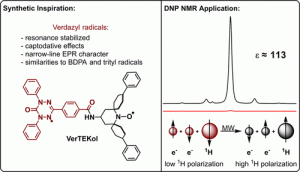Exploring the Potential of Verdazyl-Based Radicals for High-Field Dynamic Nuclear Polarization NMR
High-field dynamic nuclear polarization nuclear magnetic resonance (DNP NMR) spectroscopy transfers polarization from unpaired electrons in polarizing agents to nuclei of interest to boost NMR sensitivity. Verdazyl biradicals are a promising choice as polarizing agents because they have been found to generate narrower electron paramagnetic resonance (EPR) signals compared to nitroxide biradicals; an advantageous characteristic for high-field DNP when operating above 400 MHz/263 GHz. The use of verdazyl radicals as DNP polarizing agents has been very limited to date, yet, recent numerical simulations have predicted that verdazyl-nitroxide hybrid biradicals could be more effective polarizing agents than nitroxide-nitroxide biradicals. Herein, the syntheses of a series of verdazyl mono- and biradicals, as well as verdazyl-nitroxide biradicals are described. These radicals were examined in high-field DNP NMR experiments (600 MHz/395 GHz), by measuring 1H signal enhancements directly and through 13C{1H} cross-polarization experiments. X-band EPR, 1H DNP field profiles, and experiments to determine the nuclear build-up times were performed for verdazyl-nitroxide biradicals VerTEMPol and VerTEKol. These hybrid biradicals provide enhancements of up to 100-fold increased signal intensities (i.e., representing >104-fold time savings), approximately four times higher than that of the nitroxide biradical TEKPol, a commonly used polarizing agent in the field.

